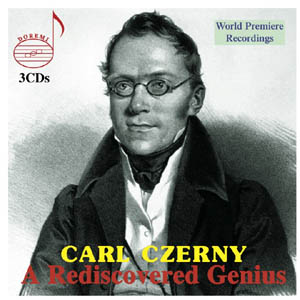CARL
CZERNY
A Rediscovered
Genius
DHR-6011-3 (3CDs)

Two String Quartets: in
E Minor and D Minor
St. Lawrence String Quartet:
Geoff Nuttall & Barry Shiffman - violins; Lesley Robertson
- viola; Marina Hoover - cello
Two Fugatos for String
Quintet Op. 177 No. 1 & No. 2
St. Lawrence String Quartet;
Erika Raum, violin
Quartet for Piano and Strings
in C Minor Op. 148
Anton Kuerti, piano; Members
of St. Lawrence String Quartet:
Barry Shiffman - violin; Lesley Robertson - viola; Marina Hoover
- cello
Grand Trio No. 2 in A Major,
Op. 166
Stéphane Lemelin,
piano; Erika Raum, violin; Thomas Wiebe, cello
Overtures in C Minor and
E Major
Edmonton Symphony, Leonard
Ratzlaff & Grzegorz Nowak, conductors
Offertorium Benedicat
nos Deus Op. 737
Jolaine Kerley - soprano;
Joy-Anne Murphy - alto; Benjamin Butterfield - tenor; Paul Grindlay
- bass
André Moisan - clarinet; Edmonton Symphony, Leonard Ratzlaff,
conductor
Grande Sérénade
Concertante in E Minor Op. 126
Stéphane Lemelin
- piano; André Moisan - clarinet; Gerald Onciul - horn;
Thomas Wiebe - cello
Variations Brillantes sur
un thème de Bellini. Piano 6 hands, Op. 297
Yaara Tal; Andreas Groethuysen;
Anton Kuerti
5 Lieder: Des Mädchens
Klage; Der Bund; Das Geheimnis; Der Erlkönig; Traum am Bach
Benjamin Butterfield -
tenor; Stéphane Lemelin - piano
Etude in C# Minor, Op.
399/10
Wonny Song - piano
Live performances from the World's First Carl Czerny
Music Festival
June 13 - 16, 2002, Edmonton, Alberta, Canada
Carl Czerny (1791-1857) occupies a pivotal niche
in music history, linking Beethoven - his teacher, the ultimate
archetype of profoundly spiritual music - with Liszt, Czerny's
student, who exemplifies the ultra-romantic and often exhibitionistic
virtuoso. Squashed between two of the most heroic, colourful and
influential personalities in the history of music, each of whom
is adulated and imitated to this day, Czerny, quite in contrast,
led a very modest, uneventful and withdrawn life, and his name
remains known only for his technical studies and etudes. This
is profoundly unjust, for hidden in his extraordinary output (well
over 1000 works, even without counting the etudes!) lie dozens
of glorious masterworks. These display a consistent perfection
of craft, a freshness of invention and an engaging sincerity that
is remarkable. The music surprises us constantly with unexpected
little original touches, some elegant, others quirky - a secret
reward for those who listen carefully. The traditional forms are
harnessed with a confidence and finesse that allows them to flow
seamlessly.
If Czerny wrote such outstanding
works, why have they remained buried out of sight? The most plausible
answer is that he became type-cast as a manufacturer of etudes
and of the mass-produced junk music - the potpourris, fantasies
and variations on the latest opera hits - that enriched his publishers
(and which they kept begging him for). Even in his shallower works
one must admire the infallible craft, the instinctive and uninhibited
mastery of melody, harmony, rhythm, counterpoint and form, and
the astonishingly inventive figurations that helped prepare the
way for the music of Liszt, Saint-Saëns, Alkan and ever so
many others. Czerny's ideas for possible permutations of patterns
for ten fingers seem inexhaustible, as is also evident in his
etudes (some of which are much more difficult than those of Chopin).
Many of the works included
in this set have never been published, and had to be deciphered
and transcribed from microfilm; almost all of the remaining ones
are out of print today. Much of the material was obtained from
the Gesellschaft der Musikfreunde in Vienna, which acquired the
composer's own collection from his estate and therefore has a
hoard of unpublished Czerny manuscripts, plus most of his published
works.
Legendary
Treasures
DOREMI
Home
